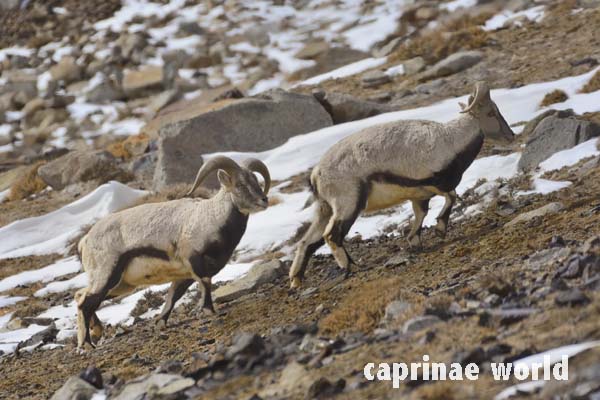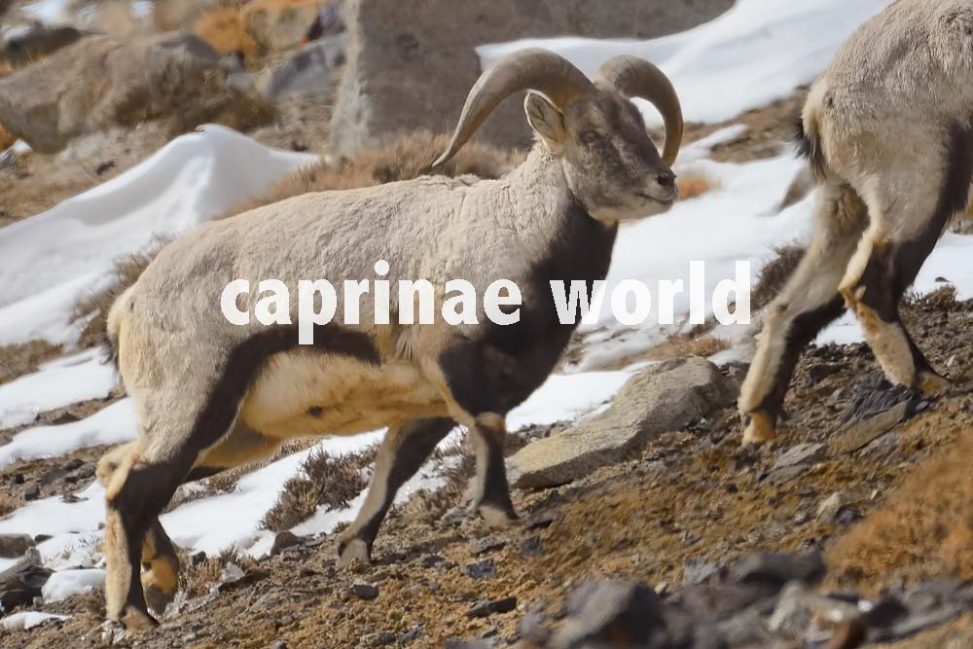The Pamir Bharal is a new (2017) putative subspecies of the Greater Bharal. It occurs at the western edge of the Bharal’s distribution range.
Tan et al. (2017) mention a Bharal population on the Pamir Plateau, Western Kunlun Mountains, Xinjiang, China. They suggest that Bharal from this westernmost region in China could be another subspecies. Like the Helan Shan Bharal in the east of China, animals from the Kunlun Mountains have been significantly differentiated. [13]
Across the border in Pakistan – even further west -, there is another subpopulation of Bharal. If the Kunlun Mountain subpopulation differs from Greater Bharal, then it is very likely that the Pakistan specimens differ too.
The same would most likely apply to animals from Tajikistan. But if Bharal occur in Tajikistan at all is still under discussion.
Name
*It seems natural to call a putative new subspecies of Bharal from the Pamir area „Pamir Bharal“ (name is not confirmed). However it is questionable if the western extension of the Chinese Kunlun Mountains is in fact part of the Pamir Plateau. The same applies to the Pakistani Khunjrab area, which is described as lying at the transition of Hindu Kush and Karakoram.
On the other hand the „Pamir Argali“ has a comparable distribution range: Only a section of its range lies within the Pamirs. It is supposed to occur also in the Kunlun Mountains (Taxkorgan Nature Reserve) as well as in the Khunjrab area. So it seems the whole region builds one continuous biogeographical unit. Therefore a transboundary name for a Bharal of this area could be in fact „Pamir Bharal“.
Distribution
Tan et al. (2017) described the new putative subspecies from the Western Kunlun Mountains, Xinjiang, China. The Kunlun Mountains (Kunlun Shan) in the broadest sense form the northern edge of the Tibetan Plateau.
The Khunjrab area in Pakistan lies adjacent to the Kunlun Mountains, at the border to China.
In general the distribution range of the Bharal in Pakistan includes the upper Gujerab Valley, the upper Shimshal Valley, and the area eastward from Shimshal Pass (District Gilgit), including part of Khunjerab National Park (Schaller 1976; Roberts 1977; Rasool 1986; Wegge 1988, 1989; G. Tallone in litt. 1993). Outside these areas there is a single observation of one animal from Khunjerab Pass (R. Hess pers. obs. 1985). Earlier, Roberts (1977) mentioned its occurrence (with proof) around Shigar and the Baltoro glacier (District Baltistan), however, there is no actual information from this area. Roberts’ (1977) source for its occurrence in the Passu Valley was a quote from Lydekker (1907) who mentioned “Hunza Valley, near Passu”, but possibly meaning the Shimshal Valley. The presence of the species in the Passu Valley is not confirmed. [6]
Grubb (2005) indicates that Bharal can be found in Tajikistan, but documentation for this is not provided, and recent surveys of the Pamir area have failed to mention find evidence of occurrence in Tajikistan (Magomedov et al. 2003, Schaller 2005), or neighboring regions of Taxkorgan County in Xinjiang, China (Schaller 2005) or Afghanistan (Schaller 2003). [6]
Description

Tan et al. (2017) do not present a description of specimens from the Kunlun Mountains. Because of the facts presented above it can be assumed that their physical appearance is similar to the specimens shown here.
Damm and Franco (2014) mention that „the rams of the Pakistani populations apparently almost never show up-turned tips“ in their horns, whereas in the Indian and Nepali populations both shapes occur. [2] What is noticeable in the specimen presented here, is the very light-coloured winter pelage.
Population
In Pakistan, Shackleton writes that, “according to written reports [Wegge 1988, Rasool 1990], the species is not as rare as previously thought … the most recent estimates indicated between 2.000 and 2.500 animals in 1992.”
Population estimates for the distribution range in China and for Tajikistan are missing.
Threats
Pakistan: An outbreak of sarcoptic mange was reported among P. nayaur in extreme northern Pakistan, and has markedly reduced abundance locally. (Woodford 2003, 2006). The limited range in Pakistan and low numbers make Bharal vulnerable to poaching and habitat loss. When access to the Shimshal Valley is opened by construction of a jeep road, the species will most probably come under increased hunting pressure. [6]
Conservation
Khunjerab National Park, in Pakistan, contains a large portion of Pakistan’s total population of Bharal. It occurs in no other protected area in this country. Conservation measures proposed for Pakistan: 1) Extend the boundaries of Khunjerab National Park eastwards. 2) Address problems faced by local people whose livelihoods would be affected by this extension. The management plan originally proposed for Khunjerab National Park did not do this, but this is necessary before its conservation recommendations can be implemented. The measures taken in the Bar valley project initiated by WWF-Pakistan and similar projects could serve as useful models. 3) Determine what detrimental influences the new road to Shimshal will have in the Park’s modified management plan. [6]
Hunting
In Pakistan trophy hunting is offered by the Wildlife Department of the Province of Gilgit-Baltistan (six permits for 2010/2011) on the plateaus of the Karakoram Mountain Range. The Karakoram Highway cuts this zone in two sections. Two community conservancies Khunjerab Villagers‘ Organisation (KVO) and the Shimshal Nature Trust (SNT) offer Bharal hunts within the Mountain Areas Conservancy Project (MACP). Hunting season is from November 1 to November 31. [2]
Bharal related Ecotourism
Not occurring. The area in Pakistan in the former state of Hunza near the Pakistan-China border is very remote. Access is subject to extensive trekking. Bharal is found at elevations between 3.660 and 4.570 metres. [2]
Literature
[2] Damm, Gerhard R. and Franco, Nicolás, 2014: The CIC Caprinae Atlas of the World – CIC International Council for Game and Wildlife Conservation, Budakeszi, Hungary in cooperation with Rowland Ward Publications RSA (Pty) Ltd., Johannesburg, South Africa
[6] Harris, R.B. 2014. Pseudois nayaur. The IUCN Red List of Threatened Species 2014: e.T61513537A64313015. https://dx.doi.org/10.2305/IUCN.UK.2014-3.RLTS.T61513537A64313015.en. Downloaded on 25 May 2020.
[13] Tan, S.; Wang, Z.; Jiang, L.; Peng, R.; Zhang, T.; Peng, Q.; Zou, F., 2017: Molecular phylogeny and phylogeography of genus Pseudois (Bovidae, Cetartiodactyla): New insights into the contrasting phylogeographic structure. Ecol Evol. 2017 Jul 31; 7(17):7047-7057.

